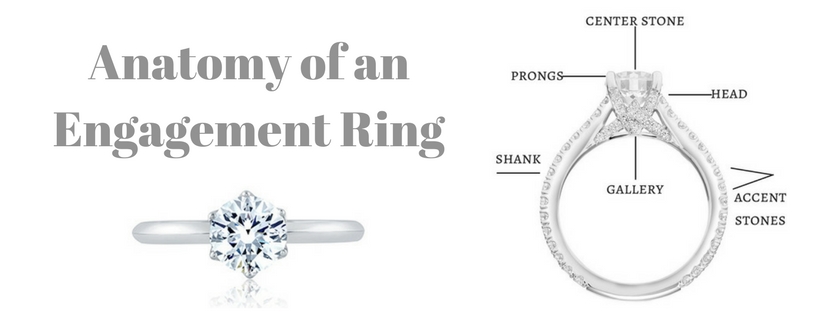Ring Anatomy 101: A Basic Guide to Engagement Ring Terminology
In this short blog, we will dissect the basic parts of an engagement ring. Leaving you with an understanding of the most commonly used terms in the jewelry industry, so that you can talk "shop" with your jeweler. This is a particularly useful guide if you are planning on designing your own custom engagement ring.
**It is important to note, this is just a basic overview of ring anatomy. Many components of a ring could have an entire blog devoted to describing in detail all of the different styles that they are available in.**
Setting or Mounting
The setting or mounting refers to the entire ring minus the center stone. In many cases, when shopping for an engagement ring you will make two separate purchases: the setting or mounting and the center stone.
Center Stone
As the name implies, this is the main gemstone in your ring. In an engagement it is mostly likely to be a diamond; however, there are many alternatives to diamonds available on the market today.
Halo
In recent years, this has become a prevailing design feature on engagement rings. The halo refers to a thin band of diamonds or gemstones around the center stone. Additionally, halos come in all different shapes, sizes and styles.
Prongs
The small metal pieces that hold the center stone or accent stones in place, since the prongs are not solid (as in a bezel); they let you see more of the stone. A traditional setting typically has 4-6 prongs and again prongs come in many different shapes, sizes and styles.
Hallmark
The hallmark is located on the inside, bottom portion of the ring. The markings indicate what precious metal was used in the construction of the ring, such as, 14k, 18k, .925 etc.
Accent Stones
These are the stones that are typically places beside the larger center stone to add decorative elements to an engagement ring. The stones are usually small diamonds; however, there are many different shapes, sizes and styles to be had in accent stones.
Shoulder
This refers to the top two sides of an engagement ring. Accent stones are often set in this portion of the ring.
Head
The center stone is held in the head of an engagement ring. There are many different types of heads, including baskets, trellises, cathedrals and bezels.
Gallery
The gallery is only visible from the side of the ring, under where the center stone is set. This is a great place to add an interesting and unique design element; the gallery can be simple and clean or very detailed and ornate.
Shank
The shank is the actual band of the ring. It is the part that goes around your finger. Again, there are many different styles of shanks: euro, tapered, split, straight etc.



